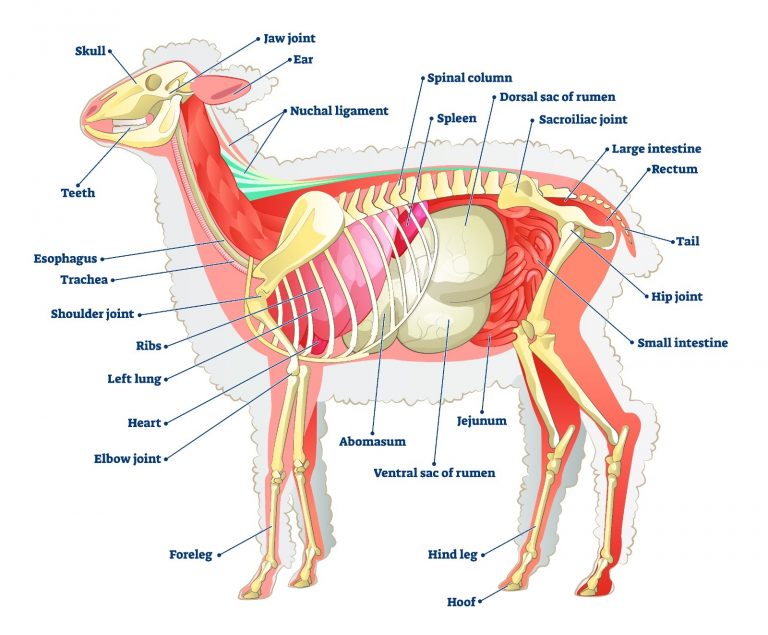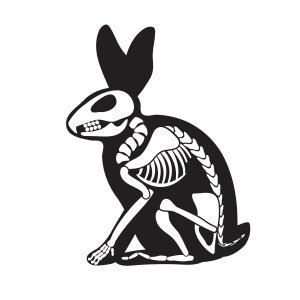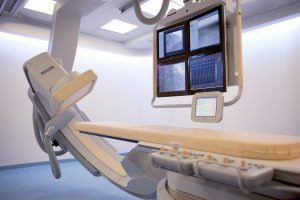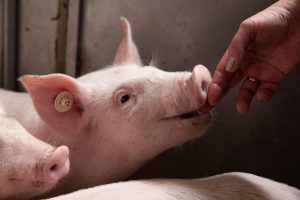How to choose a large animal model for preclinical studies – Sheep models
In our previous blog we discussed Swine models and the many factors involved in choosing the most suitable animal model including regulatory standards and ethics, the suitability of specific species to match the product specialty, anatomical differences between humans and animals, etc.
Lahav CRO specializes in pre-clinical testing with large animal models including swine and sheep. Here we will discuss the characteristics of various sheep models and briefly explain their suitability for various pre-clinical studies.
Sheep as animal models – advantages
There are many reasons for choosing sheep models for your pre-clinical studies. Since sheep are relatively long living mammals, with gryrencephalic brains, and similar body mass to humans, sheep models provide a valuable tool for understanding for testing and advancing human sized applications. Additional anatomical similarities to humans include the distribution of cerebral white matter, thick meninges, the structure of the dorsal striatum as well as a cerebral cortex comprised of four lobes. Another feature of this model is that the sheep fit into neuroimaging technology, such as MRI, CT and PT. Reynolds
One of the benefits of sheep models is that sheep reach full size at approximately 18 months. Full size for this model is 80-100kg, whereas swine reach a much larger size. The sheep, closer in weight to humans, makes the sheep models ideal for lengthy pre-clinical studies, as well as focusing on chronic conditions.
Sheep models are the preferred model for several therapeutic areas. These include, but not limited to, cardiovascular and orthopedic studies. This blog will focus on sheep models in these therapeutic areas.
Sheep as animal models
Orthopedic Research
The skeletal anatomical structure of sheep is very similar to humans. As a result, sheep models have become a popular choice for pre-clinical orthopedic studies.
Sheep models can incorporate the safety and efficacy demands required for studies on orthopedic devices and implants, including the use of arthroscopy for more precise observation. Long bones such as the Tibia are superficial, therefore surgical access to them is easy.
The knee: The width of the sheep medial-lateral tibial plateau is the largest of the animal models and therefore most similar to humans in size. The size and proportion of the human medial meniscus is most similar to the sheep and goat specimens. The picture below demonstrates the similarity between the human and sheep knee.
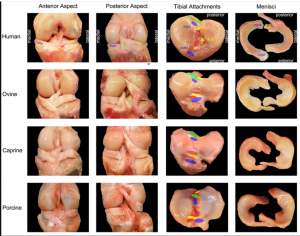

The spine:
When choosing an animal model for orthopedic studies involving the spine, there are several comparative features to consider that are specific to the spine. These features include:
- Given that the animal does not stand in an upright position (vertical posture), there is less load on vertebrae than with humans
- Different spine areas (clivus, cervical, thoracic, lumbar, sacral, coccyx)
- The age of the animal – when the model’s bone structure reaches maturity
- Follow-up time -if the study is lengthy, it is important to have a model with a slower growth rate
- Motion – depending on the focus, the range of motion of the model may be an important factor
Below: The diagram of the animal model, vertically placed next to the human diagram provides a helpful visualization.
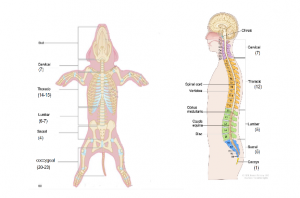



Cardiovascular Research
As discussed in the previous blog, it is important with implants that the dimensions remain the same and do not change throughout the study. Should the dimensions change, the study would lose legitimacy. As sheep grow at a slower rate, and reach maturity at weights and sizes more similar to humans, they have become an established standard model for pre-clinical cardiovascular research, especially for lengthy studies. The relative slow growth rate of ensures that the heart, artery, veins remain more or less in the same dimensions throughout.
From both an anatomical and physiological perspective, there are many cardiovascular similarities between sheep and humans. These similarities confirm the use of sheep models for cardiovascular research.
- Sheep hearts are close in size and weight to human hearts.
- There is a similarity in mechanical properties and hemodynamic flow parameters.
- Sheep heart valves can be grown and remodeled within several months. Sheep models are the FDA approved pre-clinical, gold standard in translational research for tissue engineered heart valve replacements.
- Pulmonary valve stent sheep models have good structural and functional outcomes.
- Sheep models show similar valvular anatomy, coronary venous anatomy, and cardiac contraction to humans. Reynolds
Breeding and care
Lahav C.R.O. use Assaf sheep, bred and grown at a local farm. The Assaf sheep are a crossbreed of the Awassi (native to Israel) and the German East Friesian, developed in Israeli during the 1950’s and ‘60’s. Pollott These sheep are superior to others found in Israel. Their breeding is a strictly managed protocol and the Assaf sheep are maintained under an intensive, well-rounded management system some 30km from Lahav.
The sheep models at Lahav are boarded completely separate from the swine, including completely separate hospitalization units, to assist in their acclimatization. Additionally, as sheep are ‘social’ animals therefore they are always housed in groups and not kept separately.
Lahav C.R.O has over 10 years’ experience working with sheep models and is Israel’s leader in pre-clinical sheep studies. They have developed a wide range of orthopedic and cardiovascular models. Lahav’s expert team works with companies to pinpoint which model is best for each company, product and goal.
Sheep are one of the most popular models of human organ systems. Reynolds If you are interesting on discussing the use of sheep models as an improvement of your translation of biomedical research for human application, please do contact us.
CitationsBanstola, Ashik, and John NJ Reynolds. “The Sheep as a Large Animal Model for the Investigation and Treatment of Human Disorders.” Biology 11.9 (2022): 1251.
Pollott, G. E., and E. Gootwine. “Reproductive performance and milk production of Assaf sheep in an intensive management system.” Journal of dairy science 87.11 (2004): 3690-3703.
Avner, Avi, Itai Sabbag, and Ehud Raanani. “Transpericardial 3D echocardiography in the sheep model, facilitating real time anatomical assessment for planning and guiding transcatheter mitral valve replacement and repair.” Cardiovascular Engineering and Technology 12.2 (2021): 158-165.
